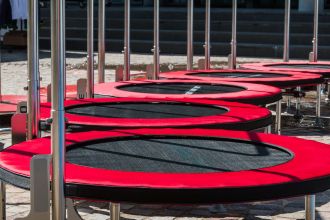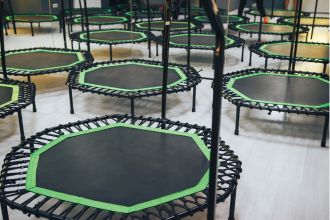While rebounding has gained popularity as a fun and effective form of exercise, it’s essential to approach any fitness activity with a balanced perspective. Just as there are pros to rebounding, downsides must be considered too.
In this article, I’ll take a closer look at the potential cons of rebounding so that you can make an informed decision about incorporating it into your fitness routine.

1. Joint Stress and Impact
While rebounding is often touted as a low-impact exercise, it still involves some level of impact on the joints, especially when performed with excessive force or improper technique. Continuous bouncing can strain the ankles, knees, and hips, particularly if you have pre-existing joint issues.
If not done correctly, rebounding can lead to joint pain, inflammation, or even injuries. It’s crucial to start slowly, use proper form, and listen to your body to avoid overloading your joints.
2. Risk of Falls and Injuries
Bouncing on a trampoline, no matter how small poses a risk of falls and injuries. The unstable surface of the trampoline increases the chances of losing balance, resulting in sprains, strains, or more severe injuries like fractures. Even if you’re an experienced rebounder, accidents can happen unexpectedly.
Practicing caution, staying within your comfort zone, and avoiding overly complex movements can help reduce the risk of accidents.
3. Lack of Variety in Workout
While rebounding engages multiple muscle groups, it may not provide the same level of exercise variety as other forms of fitness. Some individuals might find the repetitive bouncing motion monotonous, leading to boredom over time.
To address this, consider incorporating different bounce variations or integrating other exercises to keep your routine exciting and engaging.
4. Limited Upper Body Engagement
Rebounding primarily focuses on the lower body muscles, including the legs, hips, and core. However, it doesn’t offer the same degree of upper-body engagement as exercises like weightlifting, push-ups, or pull-ups.
If you’re looking for a well-rounded workout targeting upper and lower body muscle groups, you might need to supplement rebounding with additional exercises.

5. Potential for Overexertion
The enjoyable nature of rebounding might lead some individuals to push themselves too hard without realizing it. Excessive bouncing, especially without proper rest intervals, can lead to overexertion and fatigue.
It’s crucial to listen to your body, take breaks, and ensure you’re not overdoing it. Gradually increasing the intensity and duration of your rebounding sessions can help prevent burnout.
6. Equipment and Space Requirements
Rebounding requires a mini trampoline, so you must invest in equipment and have enough space for it at home or in your workout area. This might be a hurdle for those with limited space or budget constraints. It’s essential to weigh the benefits of rebounding against the space and financial considerations.
7. Not Suitable for Everyone
While rebounding is generally considered safe for most people, it might not suit individuals with certain health conditions or physical limitations. Those with balance issues, heart problems, or specific joint concerns should consult a medical professional before incorporating rebounding into their routine.
Pregnant women should also exercise caution due to the potential for balance changes and increased pressure on the pelvic area.
In Conclusion
As with any fitness activity, rebounding has its share of drawbacks that need to be carefully considered. While it offers unique benefits like low-impact cardio and lymphatic system stimulation, it’s essential to acknowledge the potential joint stress, risk of injuries, and limitations in workout variety.
To make the most of rebounding while minimizing its cons, maintain proper form, gradually increase intensity, and supplement your routine with other forms of exercise. Remember that every individual’s fitness journey is unique, so assess whether rebounding aligns with your goals and physical capabilities before bouncing into it.

Jane is a writer and co-founder of pickoutdoorgear.com. She is a fitness enthusiast and also loves outdoor activities. Through her work and writing, she focuses on improving fitness and the basics of happiness.





